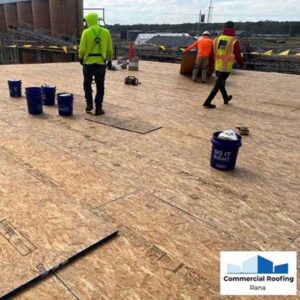
Commercial buildings in Columbus, Ohio are subject to the harsh climate and weather conditions that can cause significant damage to their roofs over time. While regular maintenance and repairs can help prolong the lifespan of a commercial roof, there comes a point when replacement becomes necessary. This article aims to provide valuable insights into the process of commercial roofing replacement, factors to consider when choosing a roofing material, cost and time considerations, and the importance of hiring a professional roofing contractor.
Understanding the Need for Roof Replacement
To fully grasp the importance of commercial roof replacement, it is essential to be aware of the signs indicating that it’s time to replace your roof. Some common signs include:
Signs Your Commercial Roof Needs Replacement
1. Persistent leaks and water damage: If you notice recurring leaks or water stains on the ceiling or walls, it may be an indication of severe roof damage.
2. Excessive wear and tear: Check for signs of cracking, blistering, or loss of granules on the roof’s surface. These are warning signs that the roof has reached the end of its lifespan.
3. Sagging or dipping roof sections: A sagging or dipping roof indicates structural issues and may require immediate replacement to prevent further damage.
4. High energy bills: An old or damaged roof can lead to poor insulation, causing your heating and cooling systems to work harder and increasing energy costs.
5. Mold or mildew growth: Excessive moisture trapped in a deteriorating roof can create a breeding ground for mold and mildew, posing health risks to occupants.
The Lifespan of Commercial Roofs
The lifespan of a commercial roof depends on various factors, including the type of roofing material used and the level of maintenance it receives. On average, commercial roofs last between 15 to 30 years, but some materials can last even longer with proper care.
Regular inspections and timely repairs can extend the lifespan of your commercial roof. Implementing a proactive maintenance plan that includes cleaning gutters, removing debris, and addressing small issues promptly can help prevent costly replacements.
Choosing the Right Roofing Material
When it comes to commercial roof replacement, selecting the right roofing material is crucial for long-term durability and cost-effectiveness. The choice of roofing material can significantly impact the overall performance and lifespan of your commercial roof. It is essential to consider various factors to ensure you make an informed decision that meets your specific needs and requirements.
One of the critical aspects to consider when choosing a roofing material is the environmental impact. Opting for eco-friendly materials can not only reduce your building’s carbon footprint but also potentially qualify you for certain green building certifications. Materials like TPO and EPDM are known for their sustainability and recyclability, making them popular choices among environmentally-conscious building owners.
Comparing Different Roofing Materials
1. TPO (Thermoplastic Olefin): Known for its energy efficiency and durability, TPO is a popular choice for commercial roofs. It offers resistance to UV rays, chemicals, and punctures. TPO roofs are also lightweight, which can help reduce the structural load on your building.
2. EPDM (Ethylene Propylene Diene Terpolymer): EPDM is a synthetic rubber roofing material that provides excellent weather resistance and is exceptionally durable. It is highly resistant to ozone, UV radiation, and extreme temperatures, making it a reliable option for various climate conditions.
3. Metal roofing: Metal roofs are known for their longevity and ability to withstand harsh weather conditions. They are also energy-efficient and have a wide range of design options. Metal roofs can be made from different materials such as steel, aluminum, and copper, each offering unique benefits in terms of durability and aesthetics.
Factors to Consider When Choosing Roofing Material
Consider the following factors when selecting a roofing material:
- Local climate and weather conditions
- Budgetary constraints
- Roof slope and complexity
- Energy efficiency and insulation requirements
- Building codes and regulations
Additionally, it is essential to assess the maintenance requirements of each roofing material. Some materials may require more frequent inspections and upkeep to ensure their longevity, while others offer low-maintenance solutions. Understanding the maintenance needs can help you plan and budget for the ongoing care of your commercial roof effectively.
The Roof Replacement Process
Replacing a commercial roof involves several stages to ensure a smooth and successful project:
Initial Inspection and Assessment
Before commencing the replacement process, a thorough inspection of the existing roof is necessary. This inspection helps identify any underlying structural issues and determines the scope of work required for the replacement.
During the initial inspection, roofing professionals will assess the condition of the roof membrane, check for any signs of water damage or leaks, and inspect the integrity of the roof’s flashing and drainage systems. This detailed assessment is crucial in developing an effective plan for the replacement project and ensuring that all potential issues are addressed.
Preparing for Roof Replacement
Prior to beginning the replacement, it’s essential to prepare the workspace. This includes removing any equipment or obstacles near the roof area and ensuring the safety of workers and occupants.
In addition to clearing the work area, preparing for roof replacement may also involve obtaining necessary permits and coordinating with building management to minimize disruptions to daily operations. Safety measures, such as installing barricades and warning signs, are put in place to protect workers and building occupants during the replacement process.
The Replacement Procedure
Once the preparation is complete, the actual replacement procedure begins. This involves removing the old roof, repairing any damaged decking, installing the new roofing material, and ensuring proper insulation and waterproofing.
During the replacement procedure, skilled roofing technicians work diligently to remove the existing roof system without causing damage to the underlying structure. Any necessary repairs to the roof deck are addressed before the new roofing material is installed. The installation process includes carefully laying out the new roofing material, ensuring proper alignment and fastening to create a durable and weather-resistant roof system. Quality control measures are implemented throughout the replacement procedure to guarantee the longevity and performance of the new roof.
Cost and Time Considerations
Replacing a commercial roof is a significant investment, and it’s crucial to consider both cost and time factors:
Estimating the Cost of Roof Replacement
The cost of roof replacement can vary depending on factors such as the size of the roof, the roofing material chosen, and the complexity of the installation. It is advisable to obtain quotes from reputable roofing contractors to determine an accurate cost estimate.
Timeline for Commercial Roof Replacement
The duration of a commercial roof replacement project will depend on various factors, including the size of the roof, weather conditions, and the complexity of the installation. Generally, it can take anywhere from a few days to a couple of weeks to complete the project.
Hiring a Professional Roofing Contractor
When it comes to commercial roof replacement, hiring a qualified and experienced roofing contractor is essential for a successful and durable outcome:
Qualities of a Reliable Roofing Contractor
1. Licensing and certifications: Ensure the contractor holds the necessary licenses and certifications required by local authorities.
2. Experience and expertise: Look for a contractor with extensive experience in commercial roofing projects, preferably with positive customer reviews.
3. Insurance coverage: Verify that the contractor carries adequate liability insurance to protect against any potential damages or accidents during the project.
Questions to Ask Your Roofing Contractor
When interviewing roofing contractors, consider asking the following questions:
- How long have you been in business?
- Can you provide references from previous commercial roofing projects?
- What is your preferred roofing material and why?
- Do you offer warranties for your work?
- What is your project timeline?
In conclusion, Columbus commercial roofing replacement is a significant undertaking that requires careful consideration. By understanding the signs indicating roof replacement, choosing the right roofing material, and hiring a professional roofing contractor, commercial building owners can ensure the longevity and durability of their roofs for years to come.
Ready to safeguard your Columbus commercial property with a roofing system that stands the test of time and weather? Look no further than Commercial Roofing Rana, your trusted partner for exceptional roofing services across the Mid-South. With our Platinum-level Duro-Last roofing systems, you’re not just getting a roof; you’re investing in unparalleled protection, inspected and verified for quality. Since 1983, we’ve been committed to delivering top-notch solutions to a variety of commercial clients, ensuring your building’s defense against the elements. Don’t wait for the next storm to question your roof’s integrity. Schedule Now! and let our licensed professionals at Commercial Roofing Rana provide you with a durable, custom-fit roofing system designed for superior protection.
